The Fine Jewelry Brand Hoping to Keep a Hawaiian Heirloom Tradition Alive
Before you actually see Meleana Estes, you'll probably hear her — or, rather, you'll here the clanking of the golden bangles stacked on her wrists.
Some of these bracelets belonged to her tūtū (grandma), renowned lei maker Amelia Ana Ka'opua Bailey; others, she's made herself. They're part of a tradition that dates back to at least the 1860s, to Lydia Lilʻu Loloku Walania Kamakaʻeha, later known as Queen Lili'uokalani, the last sovereign of Hawai'i; she wore one in an official portrait from 1862, engraved in black enamel Gothic lettering with the phrase "Ho'omana'o Mau," meaning "to remember always." Inspired by the beloved royal, many Hawaiians began making their own versions of these bracelets as heirlooms, gifted at important occasions and then passed down from one generation to the next.
Estes and fellow native Hawaiian Noël Shaw both inherited these bracelets from matriarchs in their families, and would talk about the ones they'd make when they eventually had kids. But, as Shaw puts it, "time just flies in life and in motherhood."
"Both of us have personal family connections that have run for generations, but once we became mothers, we didn't continue the tradition," she says. "We just were in disbelief. I was just really sad that it wasn't continuing in my family."
"I've been consistently wearing my bracelets since they were given to me at age 16 and 18, and the amount of times I got stopped by people saying, 'Oh my gosh, I love the style. My grandma's got stolen,' or, 'I haven't been able to find any like it,'" Estes says. "There's clearly a gap in this Hawaiian heirloom-style jewelry that wasn't really there or being filled."
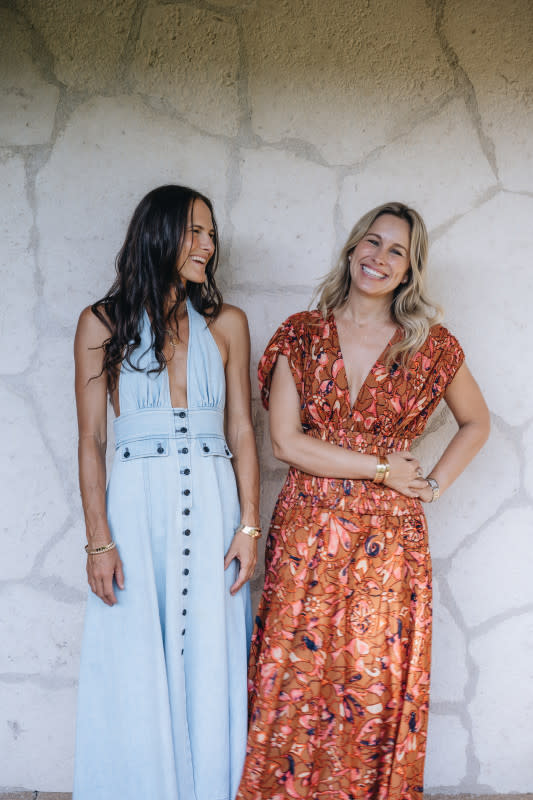
Photo: Jenn Ellenburg/Courtesy of Hie
Historically, families would go to their local jeweler to have a bracelet custom-made with either a family member's name or a phrase, as well as any symbols they might want represented in their heirloom. But over time, the practice has evolved, largely fueled by the tourism industry.
"Along the way, the product has changed to something that didn't work for us, the way it was sold in the masses," Shaw explains. "Now, buyers want a more immediate response when they're spending this level of money on a fine jewelry product… The businesses that have scaled in our space in Hawai'i have catered to the tourists, so they've lost us along the way. The original artisans either haven't passed it on or [their bracelets] might not look exactly the same."
"They'd all be this homogenized, chunky thing," Estes adds.
Realizing that their children were getting older and that the clock was ticking on the customary timeline of passing on the bracelets, Estes and Shaw got to work, and set out to create their own heirlooms.
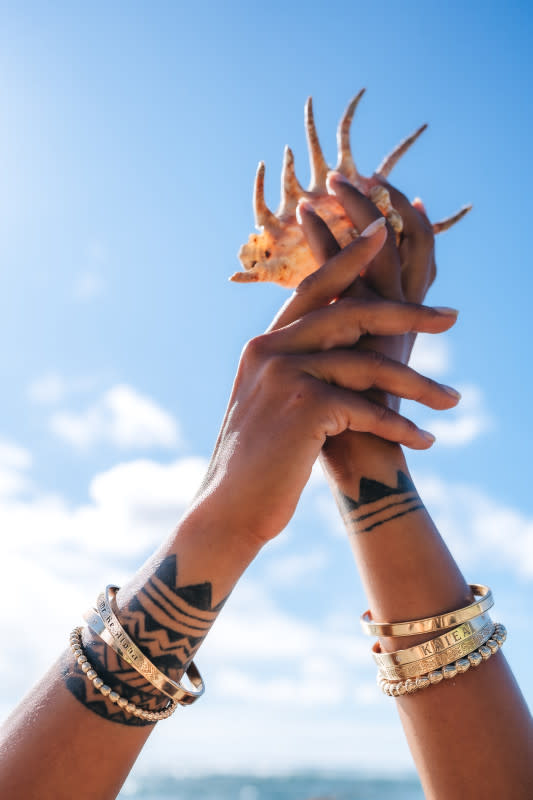
Photo: Jenn Ellenburg/Courtesy of Hie
"We're not jewelry designers, so when the first samples came back, we didn't like them. We weren't satisfied," Shaw says.
According to Estes, they'd go back and forth with their production person — someone that they met through their kids' school — to be like, "'I know you're used to doing that, but please dial it back,' and really being patient and understanding that they haven't really done this style for so long."
This took about four years, plus a pandemic. It wasn't their intention to start a brand — it just sort of... happened.
"We learned a lot along the way, and we almost had a line because we had designed so many [bracelets,] trying to work through it and learn," says Shaw. "[We thought,] 'We should share this, not just with ourselves, to have bracelets, but with anyone who would like.' Mele and I are that way: We're not the kind of girls that want the dress and no one else can have it. We're of the spirit of Hawai'i, of abundance and sharing."
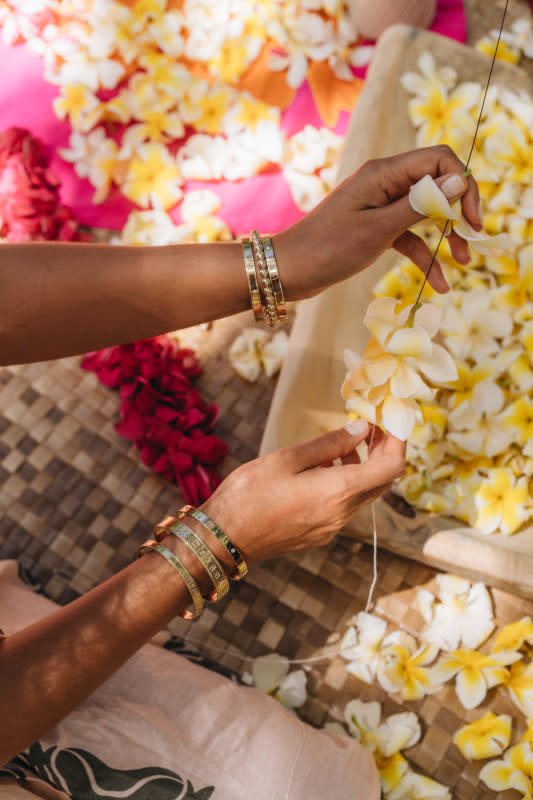
Photo: Jenn Ellenburg/Courtesy of Hie
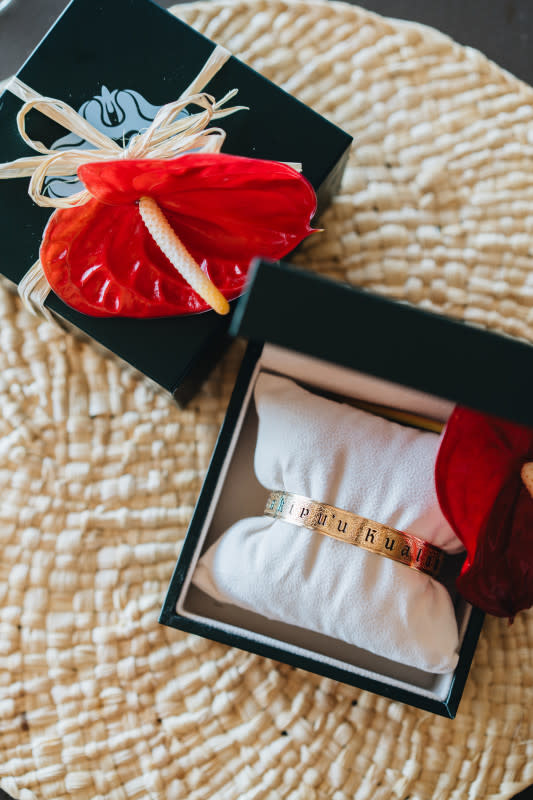
Photo: Jenn Ellenburg/Courtesy of Hie
Estes and Shaw launched Hie in early 2023 from Honolulu, where they both now live. The name comes from the word "māhie, which, can mean "attractive, distinguished, dignified, noble, becoming."
"We were given a lot of advice, like, 'You should really not name it a Hawaiian name — if anything, just put 'aloha' in there. Don't name it something too difficult for people outside of Hawaii to say.' But we didn't really care," recalls Estes. "We just wanted the name to be right. The whole genesis of the brand and of Hawaiian jewelry, really, started with Queen Lili'uokalani, and [she] was such a revered person in our culture, and still is, and meant so much to the Hawaiian people, and still does. It represented this matriarchal spirit of inclusion and love. We wanted whichever name we chose to really honor her. If you can't put the effort into understanding the name, understanding why it's named that and understanding our history, maybe you're not meant to be our customer. It's not for everybody. And we're okay with that."
The collection currently includes nine gold bracelets (rose, 14K or 18K), starting at $2,400; most can be engraved in the interior with a message, and they're meant to be worn all the time, whether your day involves surfing or picking up kids from school. Some are made right in Waikiki; if a bracelet has pikake (jasmine) beads, diamond casts or a special carving, that process happens overseas. Hie is sold online through its website, as well as at select Goop stores and boutiques at different luxury resorts across Hawai'i.
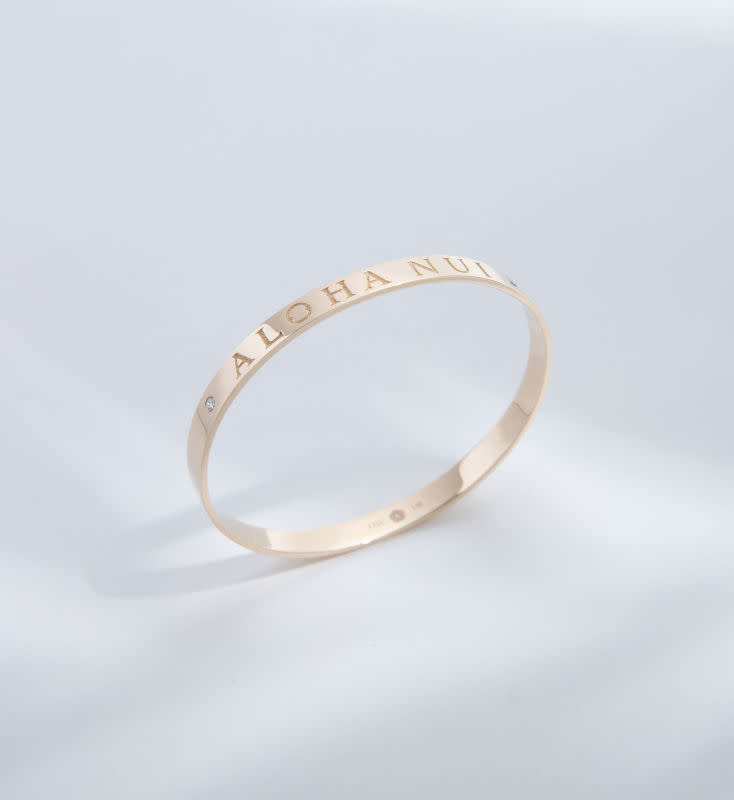
Hie Aloha Nui, $3,600, available here
View the 13 images of this gallery on the original article
Estes has a background in lei. (She authored a book on the subject.) So, for Hie, she and Shaw wanted to have a signature flower that embodied the spirit of the brand. Instead of pulling from the breadth of Hawai'i's flora, though, they decided to create their own.
"As much as we love every single flower here, certain ones have more meaning than others to us," Estes explains. "It's a combination of our queen's favorite flower, which was the crown flower and the English Tudor Rose," which ties back to Queen Victoria, with whom Queen Lili'uokalani shared a friendship (and bracelets).
"It's really fun because at our trunk shows, we always try to provide lei of crown flower, because we want to show people that connection," she continues. "We love to tell these stories and explain where all these things come from."
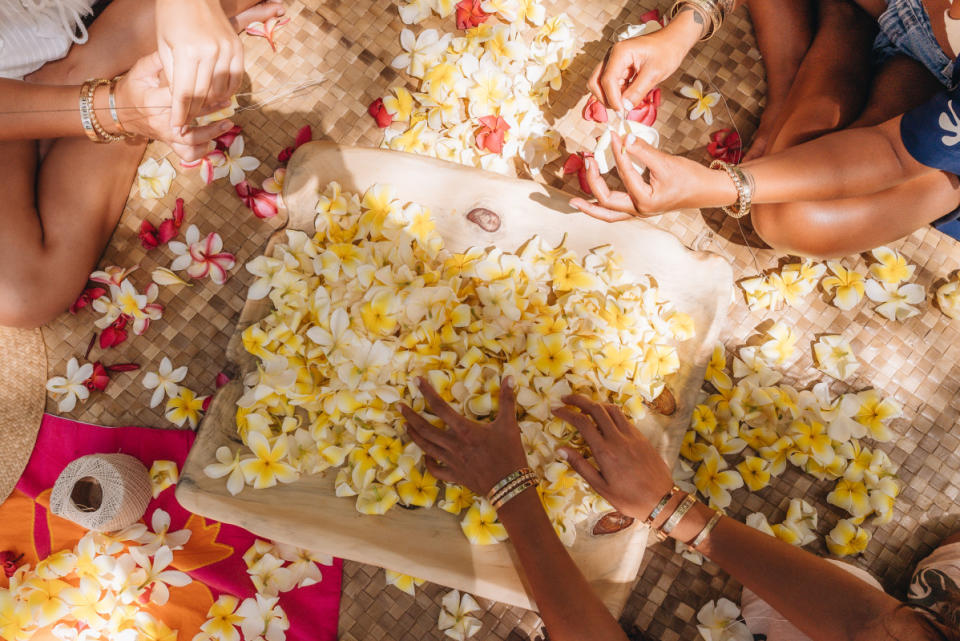
Photo: Jenn Ellenburg/Courtesy of Hie
Education is a big part of the equation. Estes and Shaw see each piece as an opportunity to teach people about the history and culture of Hawai'i. This comes with a responsibility that neither take lightly.
"You want to do it right and you feel a responsibility to do it right," Estes says. "We wanted Hawaii to be proud of us, in a way, and feel honored that we tried to do this in the best way."
"There are boundaries that we've had to make sure that what we do is appropriate for the business, for us and for everybody else that shares in this tradition," Shaw adds. For example, Hie might choose not to incorporate a symbol into its designs that might be connected to a family crest the founders have no ties to; or, if someone who's not Hawaiian wants to customize a pice with a Hawaiian word, they'll work closely with them to find one that connects with them (versus something they might've found online).
"We were in L.A. for a trunk show at Goop, and we did get some questions like, 'I'm not from Hawaii — would it be appropriate if I get the bracelet?,'" Shaw remembers. "We were like, 'The fact that you're even asking that means you're so ready to participate.'"
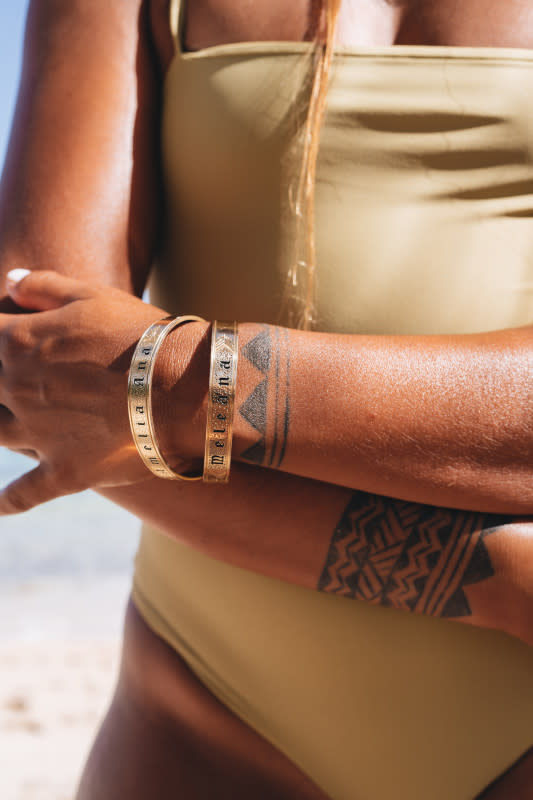
Photo: Jenn Ellenburg/Courtesy of Hie
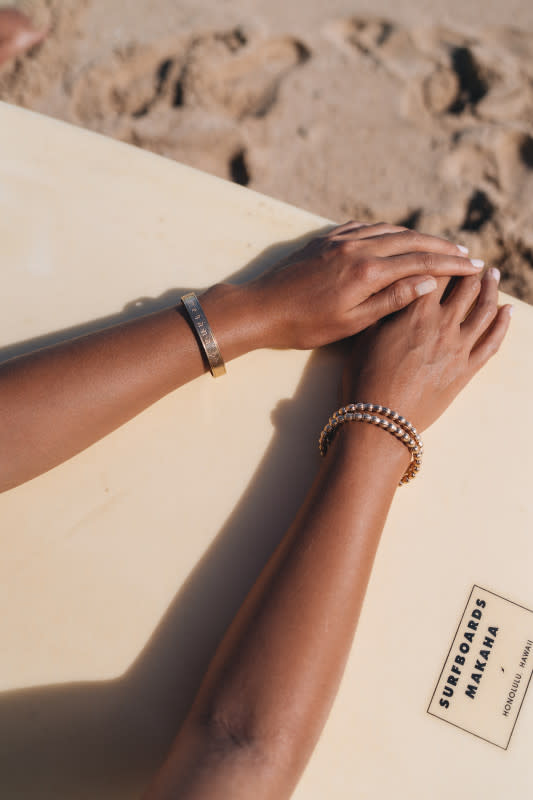
Photo: Jenn Ellenburg/Courtesy of Hie
When they were first talking about turning their four years of samples into a fine jewelry brand specializing in heirloom bracelets, Estes and Shaw heard a lot of, "I don't know if there's a market for this." But driven by their own personal desire, they persevered — and almost a year in, the customer has shown up in spades.
"As you develop and grow businesses, you can't listen to every single thing that someone says," Shaw says. "This doesn't need to be a huge scaled business, but we know there's a market. We live in it. We see that there's this gap. And we were right. We're growing above pace, above our goals by more than 40%."
For Estes, the real opportunity is in longevity: "To create connections with people that will probably last now for generations — maybe [a customer's] daughter will now look to us to create another bracelet at some point. Creating those longtime customers, like when a first person gets their first Tiffany & Co. item and then they want to keep buying Tiffany."
As Hie approaches its first anniversary, Estes and Shaw are thinking to the future, plotting ways to grow the brand's offering in a way that's thoughtful and feels true to its spirit. Its first foray into other jewelry categories will come in the form of a gold necklace inspired by lei pikake, which represents a special occasion and uses a flower associated with the late Princess Kaʻiulani.
"Everything we make is a chance to educate people on different fun facts about Hawaii and what things mean to us," she explains. "We're producing things with intention."
Please note: Occasionally, we use affiliate links on our site. This in no way affects our editorial decision-making.
Want the latest fashion industry news first? Sign up for our daily newsletter.


